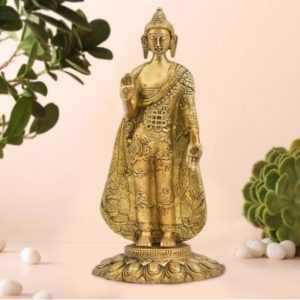The Life of Siddhartha Gautama, Who Became the Buddha


The Buddha (or Siddhartha Gautam) was born around 560 B.C.E. He lived in Northern India and was a prince highly interested in learning about Buddhism. He eventually renounced his throne and became a monk.
Siddhartha Gautama was a man who had a very adventurous life, and it wasn’t until later that he decided to become Buddha idols for home. His story is full of twists and turns, and it’s interesting to see how he changed from being an average person to become a great spiritual leader.
Siddhartha was born around 563 B.C. in Lumbini, Nepal, to a wealthy family. His father was King Suddhodana, who had three wives. At birth, he was given the name Siddhartha (meaning “he who achieves his aim”). At age 14, he renounced his kingdom and became a monk. He lived in the Himalayan foothills near Kapilavastu, where he studied under several teachers.
In Bodhgaya, India, brass Buddha idol attained enlightenment on the night of the full moon in 431 B.C. His spiritual awakening changed him forever. He saw the nature of reality as it truly is—impermanent, empty, and free from suffering. He realized that all beings had been trapped in samsara since beginning less time, and they suffered due to ignorance. He resolved to teach others how to end their suffering.
His teachings spread rapidly across Asia and eventually reached China, Tibet, Korea, Japan, Southeast Asia, and Central America. Buddhism comes from the Sanskrit term Buddhism, meaning “the way to awaken.” Today, Buddhists make up approximately 2% of the world’s population.
Bodhidharmaka (literally, “one who awakens mind”), known as the First Patriarch of Zen, is regarded as the founder of Ch’an (Zen) Buddhism. He is said to have been born in 480 A.D. and died in 543 A.D. He came from north India and settled in Shaolin Monastery in south China. He transmitted the Way of Chan Buddhism to many disciples, including Hui-yuan, Lin-chi, Mazu Daoyi, Huangbo Xiyun, etc.
Hui-yuan (555–603 A.D.), also known as Huike, was a Chinese brass Buddha idol monk who founded Tiantai School. He was born in the state of Qi (Guangzhou), now Guangdong province. He was a disciple of Linji Yixuan and received Dharma transmission from him. He is best known for writing the Platform Sutra.
Linji Yixian (701–790 A D) was a Chinese Zen Master, teacher, poet, calligrapher, painter, and musician. He was born in Zhenjiang, Jiangsu Province. He was a disciple and successor of Baizhang Huaihai. He is considered the founder of the Rinzai school of Japanese Zen.
Mazu Daohui (709–874 A.D.) was a Chinese Zen Master. He was born in a poor farming village in modern-day Henan Province. His family was very religious, and he grew up practicing meditation. When he was 16, he met the famous Zen master Hongzhi Zhengjue. After studying with Hongzhi Zhengjie, he went to live at Mount Lu Shan Temple, where he practiced meditation and mastered the art of painting. He became a great artist and gained fame in his lifetime. He later moved back to his hometown to become its abbot.
Huineng (779–851 A.D.) Buddha idols for home were an eminent Chinese Zen Master and ancestor of both the Linji and Caodong schools. Born in 783 A.D. in Hangzhou, Zhejiang Province, he was the son of a wealthy merchant. He was a student of the renowned Zen Master Dahui and became a teacher himself after receiving dharma transmission from him. He was also a close friend of the Sixth Ancestor, Huairang.
After his enlightenment, Siddhartha traveled throughout northern India, seeking out those ready to hear what he had learned. He taught them about non-attachment and the Four Noble Truths. In the end, he sat down beneath the Bodhi tree and gave his first sermon on the path to enlightenment. He then spent the rest of his life teaching others how to achieve nirvana.
DISCLAIMER: The author is solely responsible for the views expressed in this article. The author carries the responsibility for citing and/or licensing of images utilized within the text.
